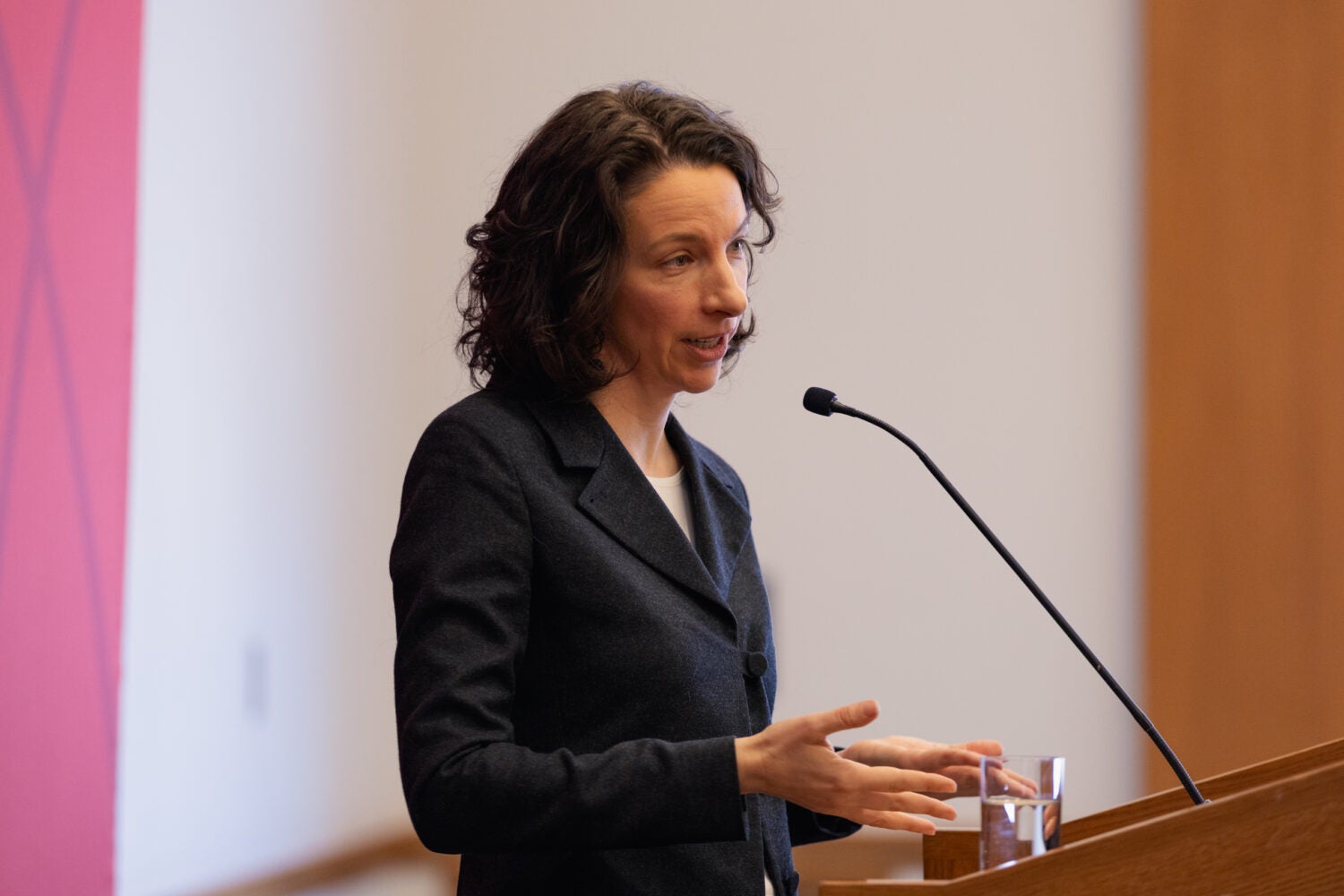During a question-and-answer session at Harvard Law School in 2015, United States Supreme Court Justice Elena Kagan ’86 famously quipped, “I think we’re all textualists now.”
Kagan, who had taught at Harvard Law and served as the school’s dean for more than five years, was paying tribute to the abiding influence of Justice Antonin Scalia ’60, often remembered as textualism’s fiercest champion, on the way judges interpret statutes. Her comment came during a lecture series named in Scalia’s honor.
A decade later, during the 2025 Justice Antonin Scalia Lecture, Judge Rachel Kovner returned to the question of whether textualism still is, or ever was, the only way most Supreme Court justices, even self-proclaimed textualists, divine the meaning behind unclear or ill-written laws.
Kovner began by reflecting on the event’s namesake, for whom she had clerked after graduating law school. Her time working as a young lawyer for Scalia, she said, “was a formative experience, not just in terms of learning about the law, but in terms of learning about how to be a lawyer, and for that matter, a judge.” She recalled how he would engage with his clerks whenever he and they disagreed about a case.
“His commitment to reasoned debate was inspiring,” she said. “Maybe a less widely known fact about Justice Scalia is that he was a mensch to work for. I never saw him lose his temper with someone in chambers, and the buck always stopped with him. I think of him often now that I’m a judge and have my own chambers.”
Kovner, who serves on U.S. District Court for the Eastern District of New York, launched into her thesis by arguing that even Supreme Court rulings reached on avowedly textualist grounds are sometimes arrived at via purpose-oriented reasoning, based on an exploration of what the statute’s authors intended it to accomplish — in other words, its purpose.
“While the Court is loath to describe itself as reasoning from purpose, it does so in statutory interpretation cases, not that infrequently, often under banners like context,” Kovner argued. “Further, while textualists like Justice Scalia left some room for the use of purpose, the current Court’s use of purpose is not really confined to the narrow limits that fit with textualist critiques of so-called purposivism.”
“Purposivism is not dead … it coexists with textualism on the Supreme Court today … [and] uses of purpose cut across the ideological spectrum.”
Textualists like Scalia, she explained, “look for meaning in the governing texts and reject judicial speculation about both drafters’ extra-textually derived purposes and the desirability of the fair readings’ anticipated consequences.” They object to more purpose-oriented approaches, she said, out of skepticism “about whether it makes sense for courts to infer a guiding purpose or spirit from a statute enacted by a multi-member body.” Legislative compromises, textualists believe, result in laws that reflect the many different, and sometimes conflicting, purposes of the multiple people who voted for them.
“Given this reality, textualists often caution that the words of the statute are the only reliable indicator of the actual bargain that the legislature made, and that abstracting an underlying purpose from the words can lead courts astray,” Kovner said.
However, although the law’s text is “currently the first stop, and in many cases, the only stop” for today’s justices, she cited Supreme Court decisions in three separate cases to support her argument that “purpose-based reasoning also plays an important role in a variety of the Court’s statutory interpretation decisions, often coming in under the label of context or history.”
In addition, she said, the consideration of factors beyond the text is not limited to the Court’s progressive wing. Instead, “these uses of purpose cut across the ideological spectrum.”
In short, Kovner argued, “purposivism is not dead, and it coexists with textualism on the Supreme Court today.”
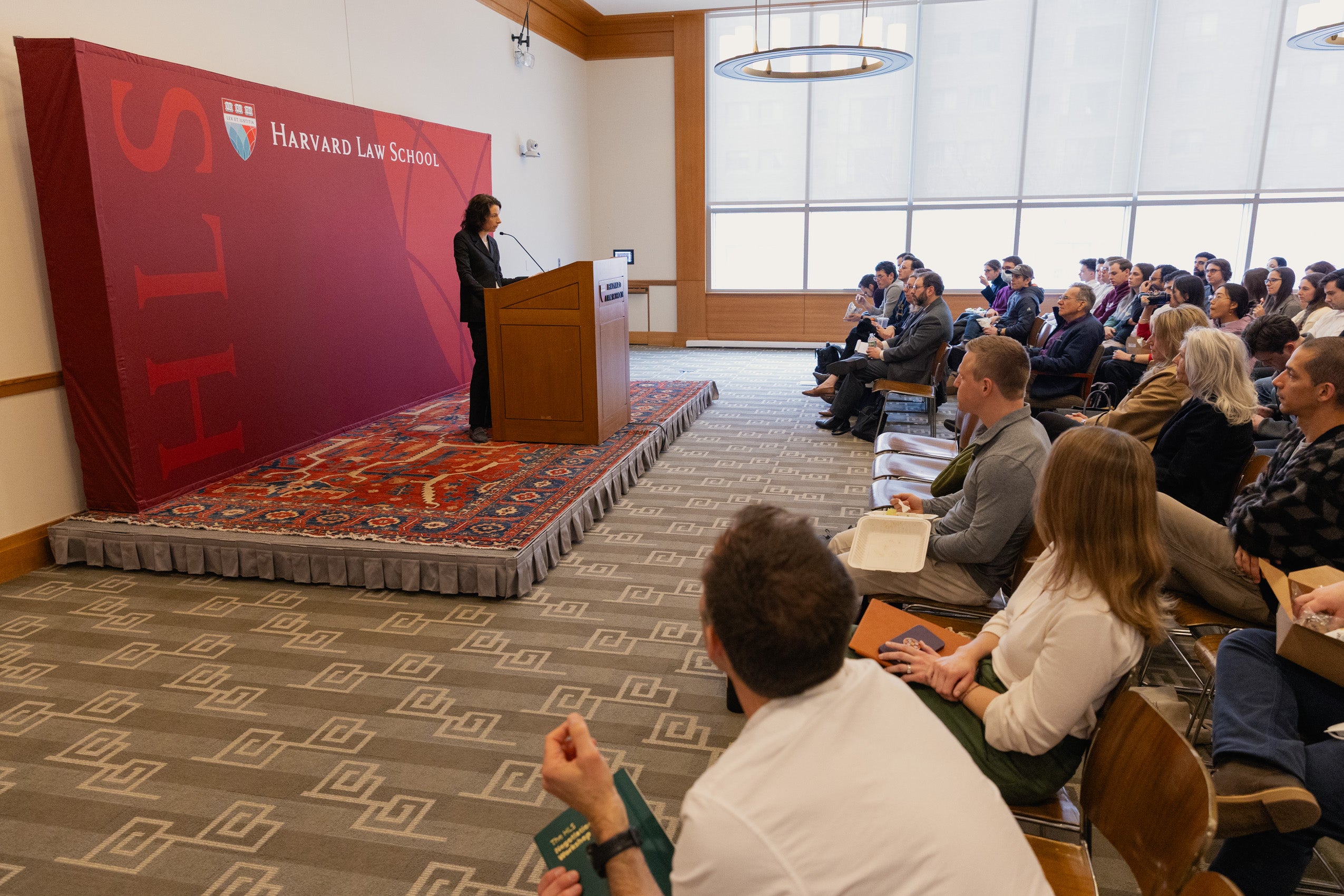
Mellouli v. Lynch, the first of the three cases she highlighted, was an “ordinary meat and potato statutory case, and it concerns whether a conviction under a Kansas drug law made an alien removable from the United States,” she said. The petitioner, Tunisian native Moones Mellouli, was convicted of a misdemeanor in state court of possession of drug paraphernalia — namely, a sock with four unidentified pills in it. The question before the Court was whether the Kansas conviction triggered deportation under federal immigration laws, which, she explained, “make removable an alien who has been ‘convicted of a violation of … any law or regulation of a state, the United States, or a foreign country relating to a controlled substance as defined under the federal drug laws.’” Kovner was particularly familiar with the case, having argued it on behalf of the U.S. Department of Justice.
In the majority opinion written by Justice Ruth Bader Ginsburg ’56-’58 and joined by Chief Justice John Roberts ’79, Scalia, Kagan, Anthony Kennedy ’61, Stephen Breyer ’64, and Sonia Sotomayor, the Court ruled in favor of Mellouli based on two pieces of “what it calls context,” Kovner said. The first is the federal government’s historic practice of tying the conviction to a drug that is federally, not just state, controlled. The second was, Kovner said, “a concern about the breadth of an alternative reading of ‘relating to,’” which might make the deportation requirement applicable to a broader set of crimes, such as gun possession, than the legislature ever intended.
The Court’s majority reached this conclusion, Kovner argued, by looking beyond the text and instead “relying on an inference that the enactors of this provision had the purpose of continuing rather than disrupting what the Court sees as historical practice of linking deportation only to convictions that inherently involve federally controlled drugs.” The justices were also “relying on an inference about how Congress would sensibly have intended to reach as a substantive matter,” she said.
The second case Kovner mentioned, Pulsifer v. United States, focused on whether the petitioner, Mark Pulsifer, could be sentenced to less than the 15-year mandatory minimum under the federal First Step Act after being convicted of drug offense. The law allowed for a defendant in his circumstances to be eligible for a sentence below the mandatory minimum under a safety valve provision, but included a list of criteria that would disqualify a person from that relief. The question for the Court, then, was whether a defendant would be disqualified if they met just one or two of the listed criteria.
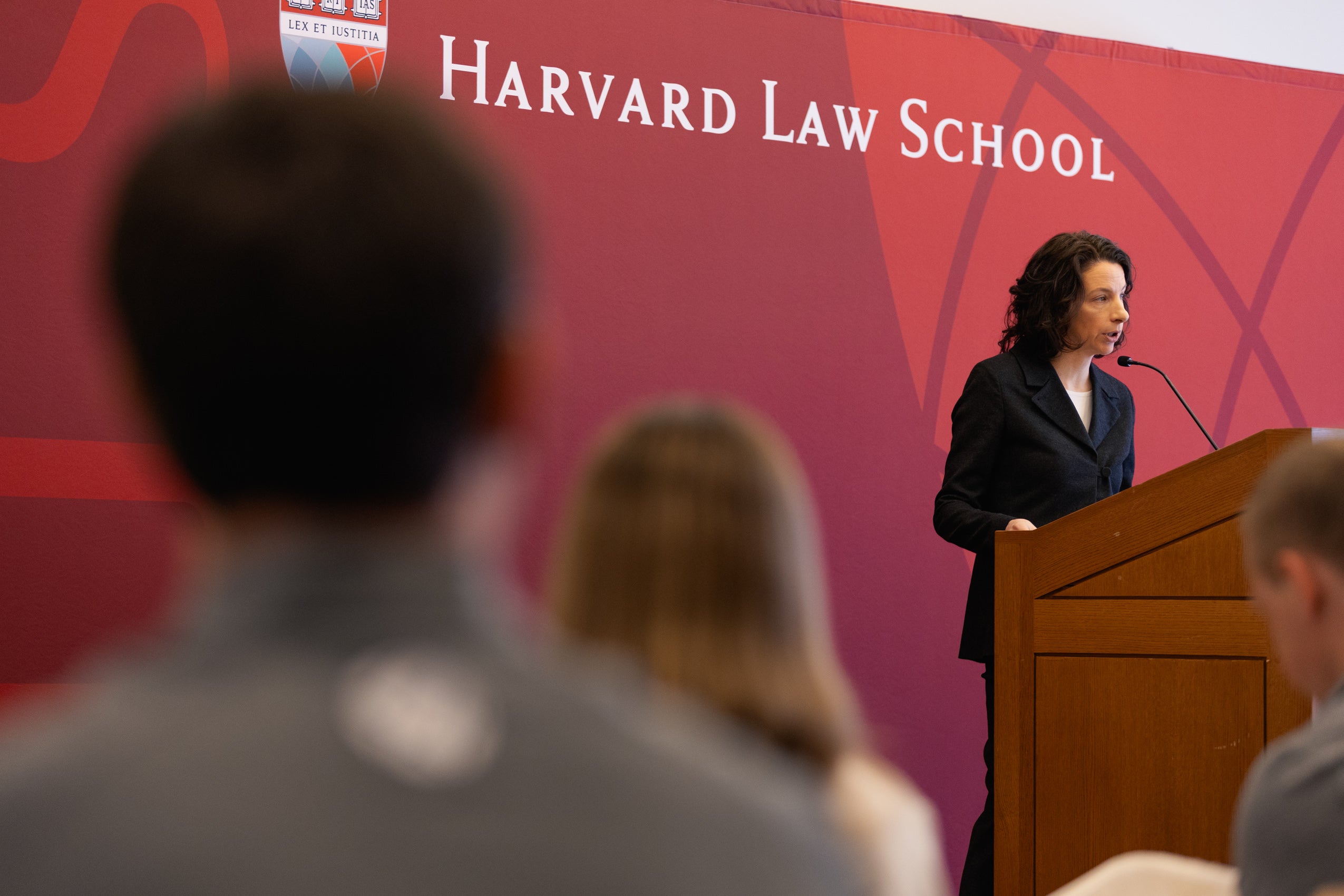
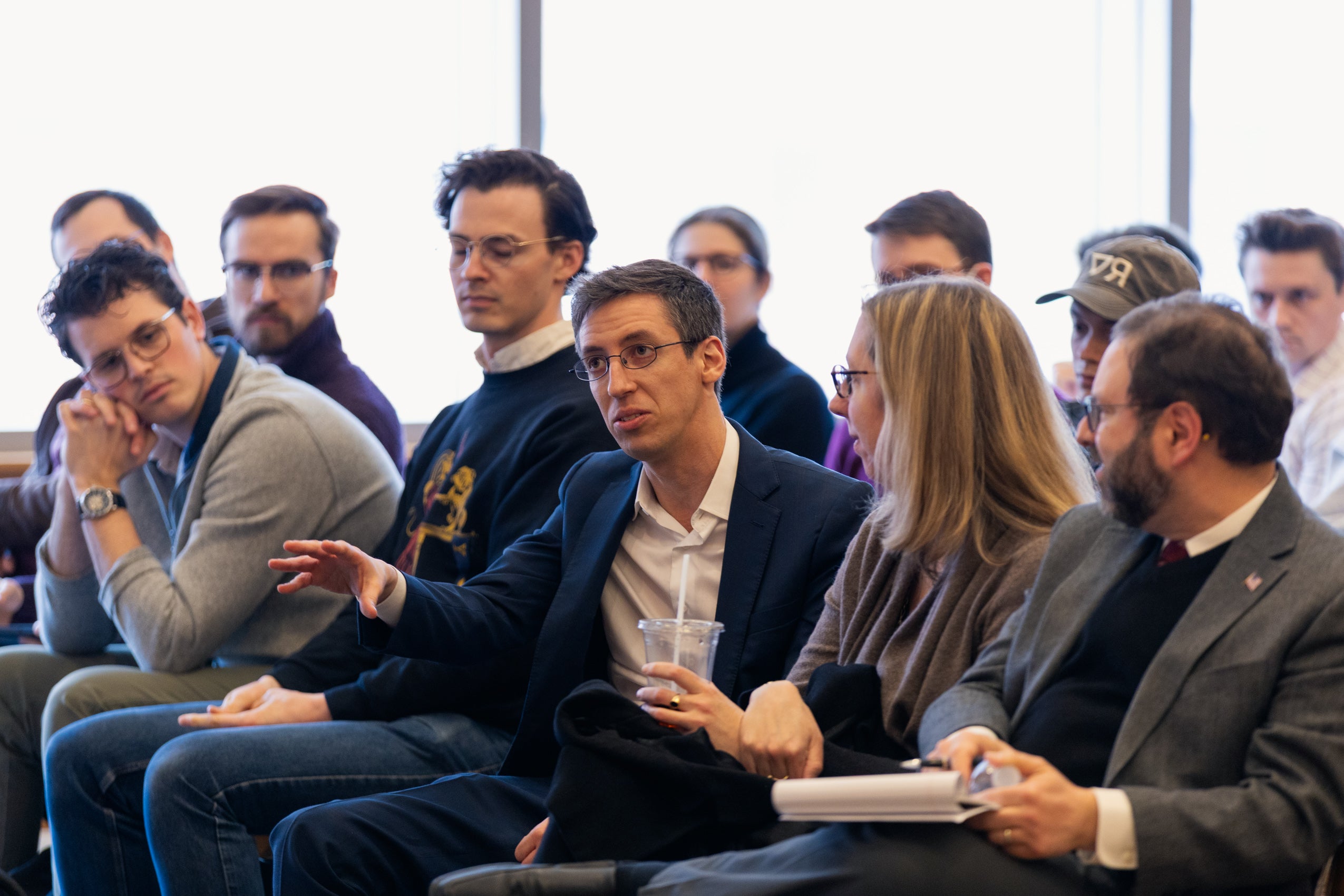
The Court ruled against Pulsifer in a 2024 opinion authored by Kagan and joined by Roberts, Samuel Alito, Amy Coney Barrett, Brett Kavanaugh, and Clarence Thomas. In doing so, Kovner noted, the majority declared that the law’s text was “ambiguous, so one must examine what it describes as content or context.” Further, the Court was troubled by an anomaly under which, Kovner explained, a “person with less serious criminal history would be ineligible” for a lower sentence, while someone else with a more serious criminal history would remain eligible for safety valve relief. According to the majority opinion, the defendant-friendly interpretation of the law “does not do a good job of separating less serious offenders from more serious offenders, [and] should be rejected,” she said.
Kovner also noted that the dissent, authored by Justice Neil Gorsuch ’91 and joined by Justices Ketanji Brown Jackson ’96 and Sotomayor, similarly indulged in extra-textualist reasoning. Gorsuch, she pointed out, called the First Step Act “the most significant criminal justice reform bill in a generation, using a description that he takes from an amicus brief filed by a senator in a different case.” He had also bemoaned the growth in the federal prison population and complained that the majority’s interpretation would provide sentencing relief to fewer defendants.
Kovner argued that Gorsuch’s citation of “background” not found in the text might lead a reader to “draw the inference that this information is being offered to advance the view that the dissent’s interpretation is superior, because the thrust of the First Step Act was to make sentences more lenient.”
Both sides, Kovner recounted, accused the other of straying from the text. “And so it is that the majority accuses the dissent of relying on a misguided argument about legislative purpose, while the dissent is accusing the majority of the same thing,” she said. “For me, that’s what makes this case especially interesting. Both the majority and the dissent seem to be considering purpose in some way … but neither side couches its own interpretation in the language of purpose. Instead, each side criticizes the other for invoking purpose when it should not.”
Her final example stemmed from the January 6, 2021 attack on the U.S. Capitol. Joseph W. Fischer had been charged with obstructing an official proceeding under a provision of the Sarbanes-Oxley Act, which Congress had passed in 2002 in response to the Enron scandal, a massive financial scandal in which companies were accused of shredding incriminating documents. One provision of the law made it a crime “to alter, destroy, mutilate or conceal a record, document or other object with the intent to impair its integrity or availability for use in an official proceeding.” The next provision, under which Fischer had been charged, she explained, “imposes penalties on anyone who ‘otherwise obstructs, influences, or impedes any official proceeding or attempts to do so.’”
In an opinion authored by Roberts, the Court ruled that the second, “otherwise,” provision is limited by the first, and invalidated Fischer’s conviction. In doing so, the Court’s majority reasoned that “[i]t would be peculiar to conclude that … Congress actually hid away, [in Section C2], a catch-all provision [in a law related to the Enron scandal] that reaches far beyond the document shredding and similar scenarios that prompted the legislation.” The Court’s assumption, argued Kovner, goes beyond what can be inferred from the text alone. Instead, she said, the decision is based more on “inferences about what a reasonable legislator would have thought or done when confronted with a particular problem, rather than inferences drawn only from the text.”
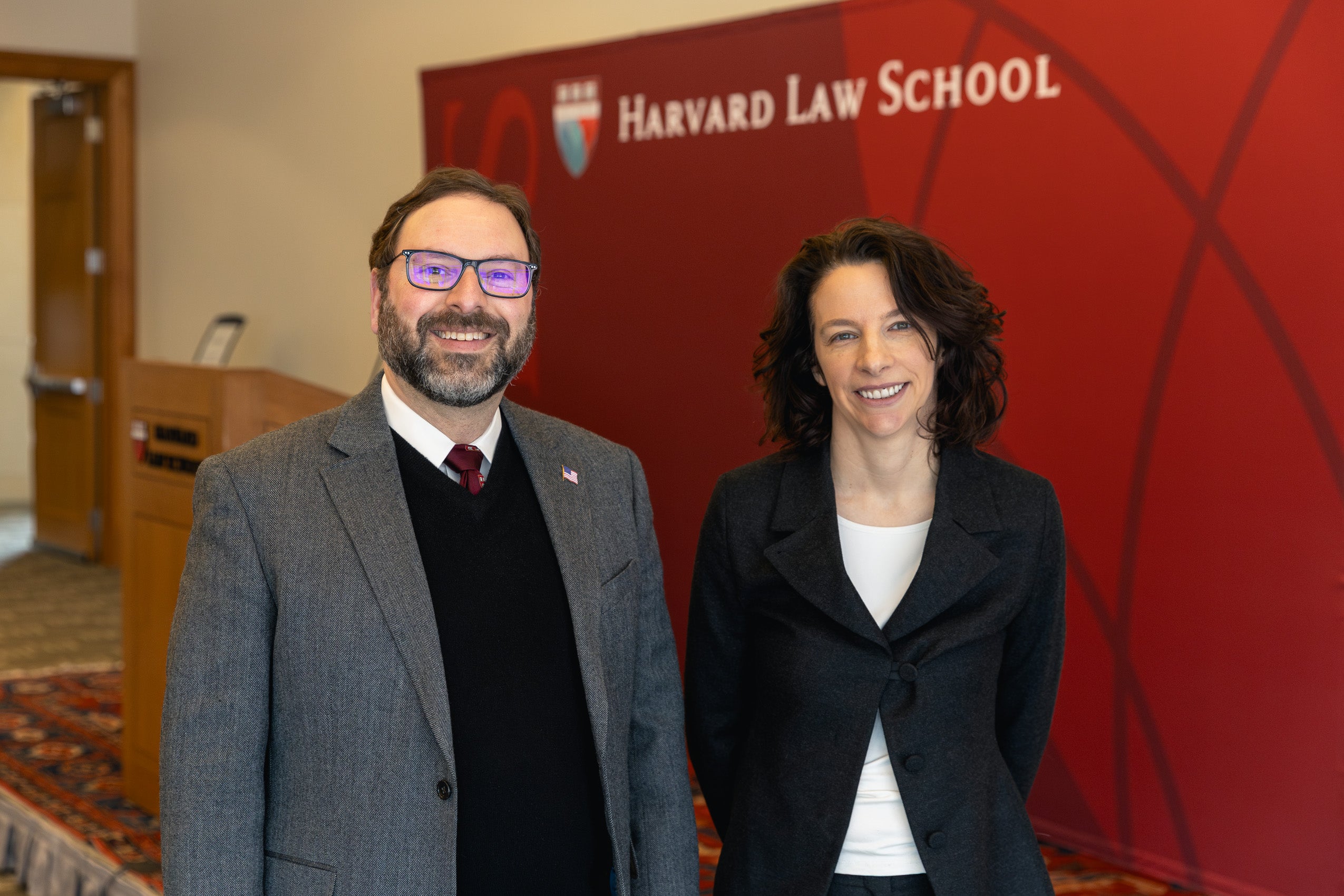
Summarizing her thesis, Kovner argued that the three cases she discussed demonstrate that, despite the textualism’s seeming ascendency, “the Court seems to be inferring what a reasonable legislator would have done when faced with a particular problem.” Moreover, she said, “[t]hat type of reasoning is in some tension … with textualist critiques of purposivism, because of how textualists see legislation as reflecting compromise between individuals with many different goals, rather than one readily ascertainable purpose.”
Finally, she noted, the “use of purpose is not limited to the group of justices who are sometimes called liberal, or, for that matter, the group of justices who are sometimes called conservative. Each of the justices generally classified as conservative signed on to at least one of the opinions I’ve just discussed. For that matter, we see justices who are often described as liberal in some of these cases joining dissents that fall to the invocation of purpose on the theory that the text is clear.”
“If textualism has triumphed on the Supreme Court, as Justice Kagan suggested, I submit that purposivism is not dead yet and continues to play a role there too,” Kovner concluded, referring again to Kagan’s 2015 statement.
Kagan, herself, now seems to agree. In her 2022 dissent in West Virginia v. EPA, in which the Court’s majority invoked the relatively novel “major questions doctrine” to rule that Congress hadn’t authorized the agency to regulate power plant emissions, she seemed to retract, or at least amend, her earlier statement.
“Some years ago, I remarked that ‘[w]e’re all textualists now.’ It seems I was wrong,” Kagan wrote. “The current Court is textualist only when being so suits it. When that method would frustrate broader goals, special canons like the ‘major questions doctrine’ magically appear as get out-of-text-free cards.”
Want to stay up to date with Harvard Law Today? Sign up for our weekly newsletter.
